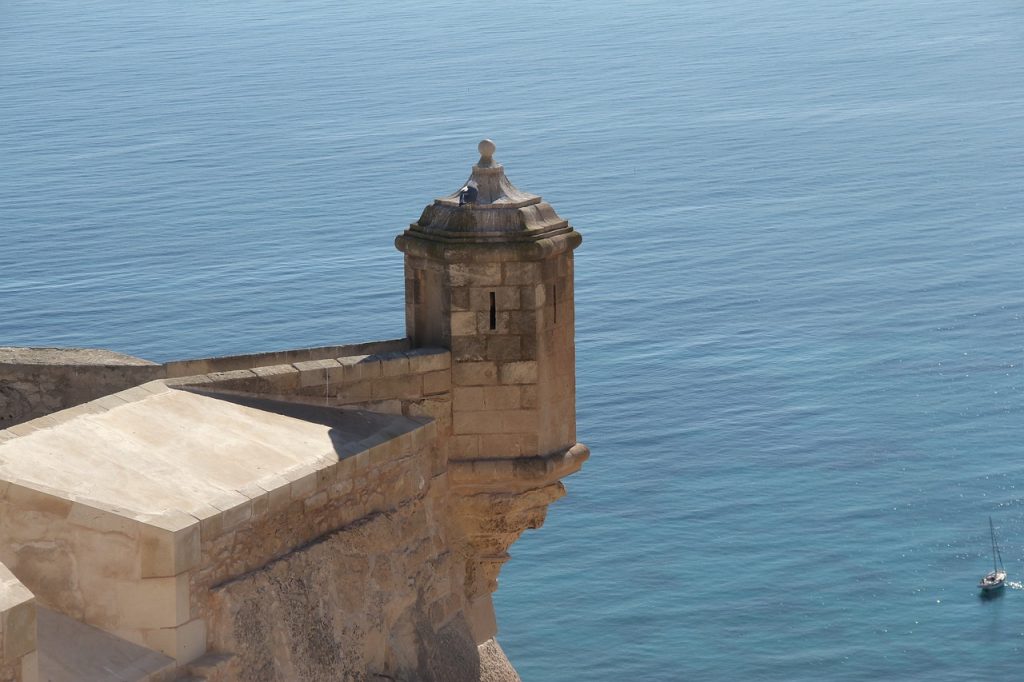Perched majestically on Mount Benacantil, at over 166 meters above sea level, the Castle of Santa Bárbara stands as a sentinel watching over the Mediterranean city of Alicante, Spain. This iconic fortress is not just a monumental relic of the past but also a living narrative that captures centuries of Spanish history, from its initial foundations during the Late Roman period to its significance in modern times. This article explores the rich history, architectural evolution, and cultural significance of this historic castle.
Historical Overview
The origins of the Castle of Santa Bárbara are believed to date back to the 9th century during the Muslim rule of Iberia. However, the majority of the current structure was built in the late Middle Ages. It was named after Saint Barbara, on whose feast day, December 4th, the castle was recaptured from the Arabs in 1248 by the Castilian forces led by Alfonso X. This strategic location provides a panoramic view of the surrounding landscape, which made it a crucial military point throughout history.
Architectural Features
The architecture of the Castle of Santa Bárbara is a testament to the various cultures that have occupied Alicante. The fortress is divided into three distinct precincts, each corresponding to different periods in history. The highest point, known as "La Torreta," features the remains of the oldest parts of the castle, including a lookout tower that dates back to the 11th century. The middle enclosure holds the most iconic elements, like the Hall of Philip II and the Governor's House, reflecting the Renaissance and Baroque styles. The lower enclosure, added in the 18th century, includes the Revellín del Bon Repós.
As visitors walk through the castle, they encounter a series of tunnels, dungeons, and ramparts, which paint a vivid picture of medieval military architecture. Notably, the castle also features a unique elevator that runs through the mountain from the beach to the top, offering easy access alongside breathtaking views.
Role in Defense and Warfare
Throughout its history, the Castle of Santa Bárbara played a pivotal role in the defense of Alicante. During the War of Spanish Succession (1701-1714), the castle was held by the English for a short period, reflecting its importance in international conflicts. Its strategic importance was highlighted once again during the Spanish Civil War (1936-1939), when it served as a bombing target and a defensive stronghold for the city.
The cannons, battlements, and fortifications of the castle speak volumes about its military significance. These features were not merely defensive but were also used as strategic tools in controlling the bay of Alicante and the surrounding territories.
Cultural and Touristic Importance
Today, the Castle of Santa Bárbara is one of Alicante's most visited tourist attractions. It is not just a monument but a cultural venue that hosts exhibitions, concerts, and a variety of cultural activities throughout the year. The castle’s museum offers detailed exhibits on the history of the fortress and the city, filled with artifacts that range from historical weapons to traditional ceramics.
The viewpoints from the castle are unparalleled, offering sweeping vistas of Alicante’s coastline, urban fabric, and the distant mountains. These views make the Castle of Santa Bárbara a favorite spot for photographers and nature enthusiasts alike.
Challenges and Conservation
Conserving a monument as ancient and vast as the Castle of Santa Bárbara is fraught with challenges. The structure has endured centuries of natural wear and tear, compounded by the damage inflicted during various sieges and wars. Current conservation efforts are focused on restoring damaged sections and preventing further degradation caused by weathering and human interaction.
The local government of Alicante has implemented several initiatives aimed at preserving the castle's integrity while making it accessible and informative for visitors. These efforts include guided tours, educational programs, and the installation of interpretative panels that provide insights into the castle's historical context.
Conclusion
The Castle of Santa Bárbara is more than just a historic fortress; it is a symbol of Alicante's resilience and cultural heritage. From its strategic military use to its role as a cultural beacon, this magnificent castle encapsulates the spirit of Alicante through the ages. Whether you are a history enthusiast, an architecture aficionado, or simply in search of a picturesque view, the Castle of Santa Bárbara offers a unique window into the past and a testament to the enduring allure of Alicante's historical landscape.
Frequently Asked Questions (FAQs)
What is the historical significance of the Castle of Santa Bárbara?
The Castle of Santa Bárbara has historical roots dating back to the 9th century and has played a crucial role in the defense of Alicante through various periods, including the Spanish Civil War
How can visitors access the Castle of Santa Bárbara?
Visitors can access the castle via road, by foot, or by using a unique elevator that runs through the mountain from the beach directly to the castle
What can tourists see and do at the Castle of Santa Bárbara?
Tourists can explore historical exhibits, enjoy panoramic views of Alicante, attend cultural events, and walk through ancient tunnels and fortifications
Are there guided tours available at the Castle of Santa Bárbara?
Yes, guided tours are available, offering in-depth insights into the castle’s history, architecture, and the role it has played in Alicante’s past
What are the best times to visit the Castle of Santa Bárbara?
The best times to visit are early morning or late afternoon to avoid the heat and crowds, with spring and autumn offering the most pleasant weather conditions
